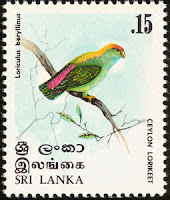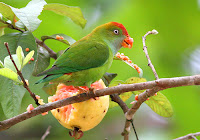 Ceylon Lorikeet - Loriculus beryllinus
Ceylon Lorikeet - Loriculus beryllinusSri Lanka Hanging Parrot
(Endemic bird in Sri Lanka)
Sinhalese - Gira Malichcha
Tamil - Kanni Killi
The Ceylon Lorikeet is the smallest member of Sri Lanka’s parrot
family. This sparrow sized bird is predominantly green with bright red
on the forehead and crown which turns into a golden orange on the nape
and hind neck before blending into the green of the mantle. The rump
and upper tail coverts are a bright scarlet. The brilliancy of this
bird’s plumage is further enhanced by its blue under wing and tail. The
male bird’s chin shows a prominent blue which is somewhat lacking in
the female, her overall plumage being duller. Young are mostly green
all over while very young birds are sparsely plumaged on the head and
neck, possibly an adaptation to the nature of food they are fed on.
The Lorikeet is well distributed in the island up to about 1200 metres elevation though it occurs rather sparingly in the dry zone, mostly in the foothills. It prefers well wooded habitat including forest but frequently visits orchards and fruit bearing gardens as well. It feeds on nectar and juicy fruit, in search of which it scrambles along branches with great agility. The Lorikeet is said to have a great affinity for the nectar of the talipot palm. The flight is swift and dashing, the birds often flying quite high. The flight is undulating and the bird utters a three syllabled ‘tchi,tchi, tchi’ call while flying. This call is uttered while foraging too but the bird is so well camouflaged in spite of its bright plumage that it is often difficult to spot while thus engaged. The bird roosts by hanging upside down - bat wise.
The breeding season is from January to August but mainly during the
period from March to May. It lays its eggs in a natural tree hole often
at some height from ground level. Henry says the female carries strips
of leaves etc to line the nest by pushing them into her voluminous rump
feathers. However it is difficult to see how this can be done without
these falling off while the bird is flying. Usually two white eggs,
quite circular in shape are laid.



No comments:
Post a Comment